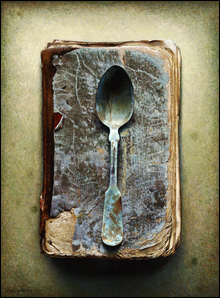
SEE THE ART AND ITS INSPIRATION
"MEMENTO,": oil on panel, 16x12, 2007.
|
At first look John Whalley’s work seems pretty straightforward. His paintings and large drawings at Greenhut Galleries in Portland seem — and are — polished, sophisticated, and highly skilled renderings of commonplace objects one might find scattered in the nooks and crannies of an old farm. Spend a little time with them, though, and it becomes clear that what meets the eye is more than simple representation.
In "Augers," a graphite drawing 50 inches high by 30 inches wide, five old augers are shown in a row. These are old-fashioned tools that were once used to drill sizeable holes in a piece of wood, typically for trunnels in wood shipbuilding or post-and-beam barns . A couple of the augers still have their handles attached at right angles to the shank of the drill.
These tools saw, in their day, hard use. The handles are cracked and repaired, the bits pitted and worn. Whalley records their presence in minute detail, using only careful graphite gradations from light to dark.
A tool long used carries something of the spirit of its owner. To handle such a tool invites imaginings about its use and its user, about the jobs it accomplished and times it was put aside for another, perhaps newer tool. In these pieces Whalley does some of that reflection for us. There is nothing overt or directly represented in this task of historical imagination, but the results are there none the less. His subjects have iconic status that is suggested by the whole gestalt of the work, by its shading, background, and by the absence of any pencil strokes or other signs of the drawing’s making. Even the signature is done with neat block letters rather than with an artsy flourish. Whalley is mediating our attention to the tools and to the tools’ unnamed former owner. His impressive technique is a means that serves his purpose, rather than an end.
|
"Mementos" drawings & paintings by John Whalley | at Greenhut Galleries, 146 Middle St, Portland | through March 29 | 207.772.2693
|
In the small oil painting "Memento," a tarnished spoon is shown placed on an old, worn book, perhaps an old diary or account book. Whoever thumbed through this book until its corners were round is long gone, and the spoon has the look of neglect, as if it spent the last forty years lost under an attic floorboard.
Whalley has provided us with clues to his thinking and his method by bringing some of the depicted objects to the gallery. We can see the book and the spoon, as well as his picture of the book and spoon. We see, for instance, that the colors of the painting are ever so slightly brighter than those of its subject. The pathos of the history implicit in the objects becomes more accessible in the picture. He has created a small, subtle act of theater that shows respect for the viewer and for anonymous former owner of the object. We are gently reminded of the presence of meaning, rather than slapped in the face with a cold, post-modernist hyper-real appropriated fish.
Whalley’s understated theater comes indoors in "Quartet." There are four forks set in a row on a battered old white plate. Three of the forks are three-tined cooking forks with wood or bone handles that were common in kitchens eighty years ago; the other is a two-tined, antler-handled fork that might have been part of a carving set. The arrangement is set on a floral pattern, perhaps a stencil on wallpaper or an old tablecloth. Once again we are getting a quiet tour through commonplace objects that were once used and valued by someone. Whalley’s use of them as subjects gives them new life in new circumstances, and does it without making a big deal about it.
Ken Greenleaf can be reached at
ken.greenleaf@gmail.com
.